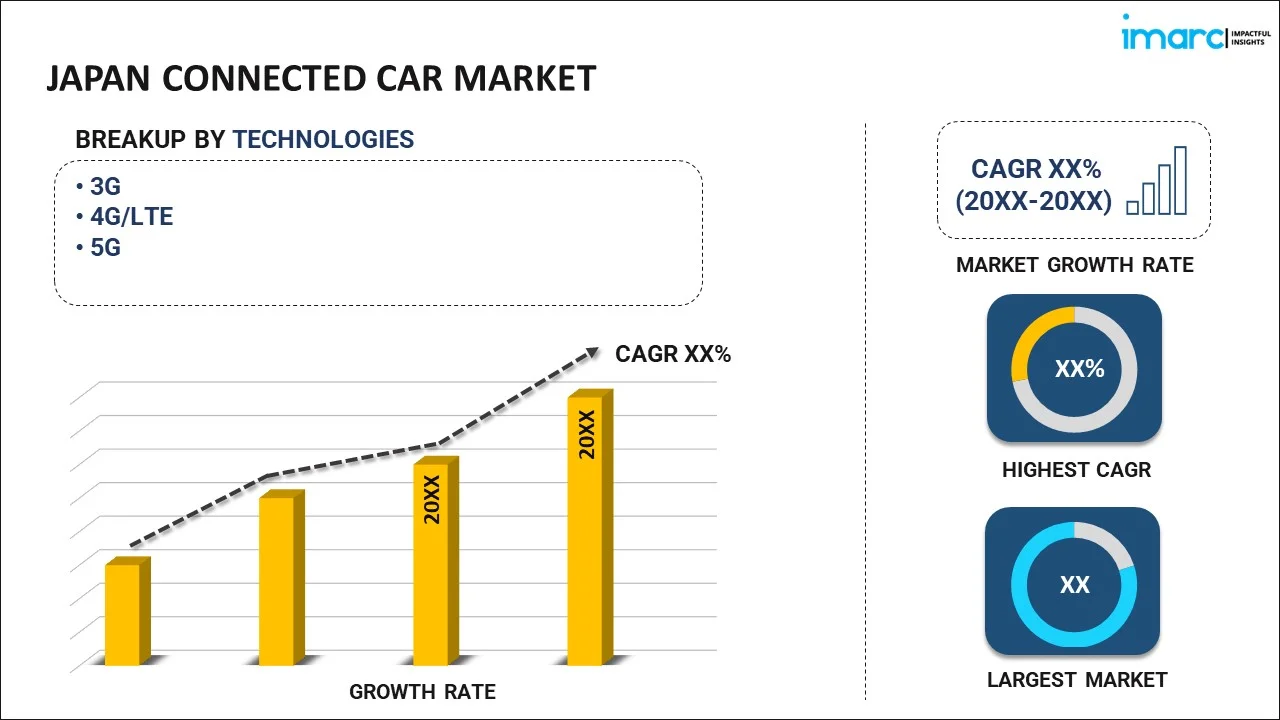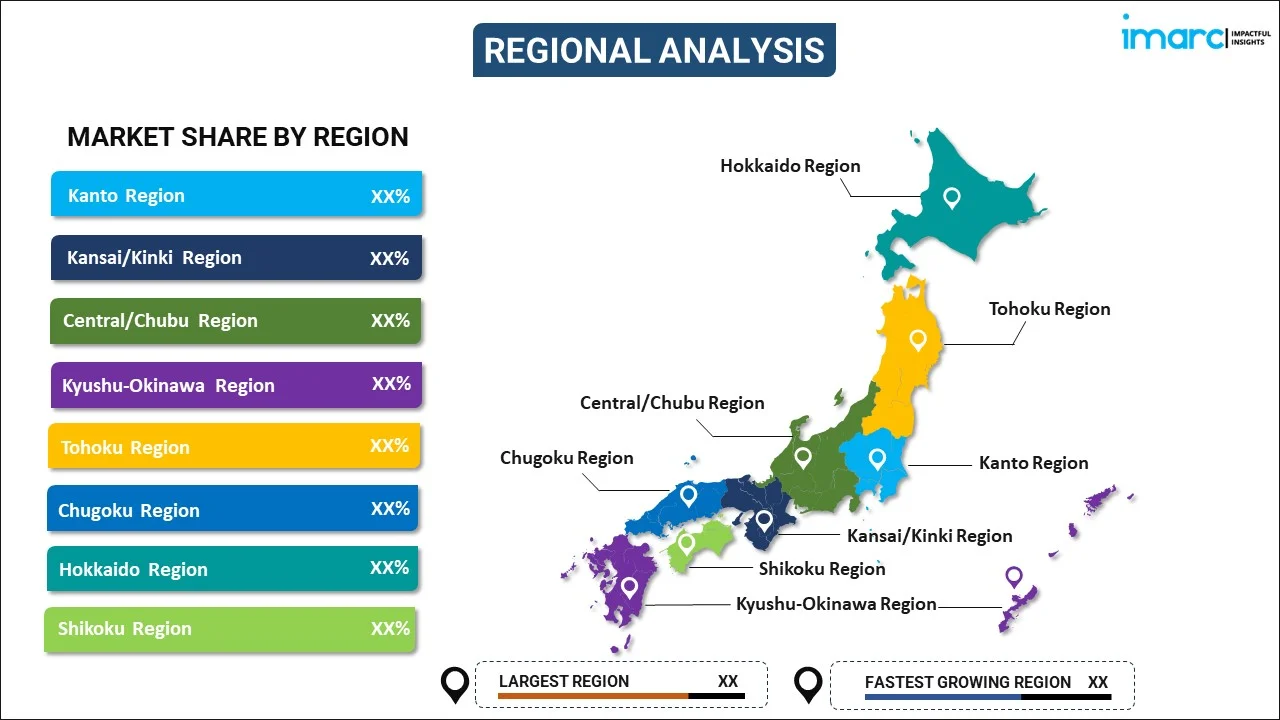
Japan Connected Car Market Report by Technology (3G,4G/LTE, 5G), Connectivity Solutions (Integrated, Embedded, Tethered), Service (Driver Assistance, Safety, Entertainment, Vehicle Management, Mobility Management, and Others), End Market (Original Equipment Manufacturer (OEMs), Aftermarket), and Region 2025-2033
Market Overview:
Japan connected car market size reached USD 6.1 Billion in 2024. Looking forward, IMARC Group expects the market to reach USD 32.1 Billion by 2033, exhibiting a growth rate (CAGR) of 20.4% during 2025-2033. The growing dependency on uninterrupted connectivity to access navigation services is providing a thrust to the market growth.
|
Report Attribute
|
Key Statistics
|
|---|---|
|
Base Year
|
2024 |
|
Forecast Years
|
2025-2033 |
|
Historical Years
|
2019-2024
|
| Market Size in 2024 | USD 6.1 Billion |
| Market Forecast in 2033 | USD 32.1 Billion |
| Market Growth Rate (2025-2033) | 20.4% |
Connected cars are automobiles integrated with internet connectivity and advanced communication technologies, enabling the seamless exchange of information through multiple communication channels. Their purpose is to enhance vehicle performance, provide added convenience to users, and enable effective communication between the transportation system and its environment to prevent road accidents and offer notifications about available parking spaces. These vehicles also deliver immediate traffic alerts to drivers and can trigger emergency services in case of unforeseen incidents. Additionally, these alerts and signals contribute to the improvement of overall traffic performance and management of road safety, all while ensuring optimal driving comfort.
Japan Connected Car Market Trends:
The Japan connected car market is primarily stimulated by the growing need for in-car safety solutions. Consequently, the extensive integration of connected cars with advanced driver-assistance systems (ADAS) for obstacle mapping and anti-lock braking systems (ABS) to facilitate secure braking is poised to foster a favorable market outlook. Additionally, the introduction of 5G connectivity and the increasing adoption of artificial intelligence (AI) and machine-to-machine (M2M) connectivity among multiple vehicles are positively influencing the market. Simultaneously, continuous advancements in the production of sophisticated suspension systems are providing further momentum to the market. The market's momentum is additionally bolstered by the increasing preference for luxury cars among individuals with substantial disposable incomes and the emergence of trends related to autonomous driving. Other contributing factors to market growth include the rapid digitalization across the automotive sector and extensive research and development (R&D) initiatives undertaken by key industry players. In addition, the enforcement of strict regulations by governments in various nations has compelled automotive producers to create vehicles equipped with ADAS attributes in response to mounting apprehensions about passenger safety, thereby aiding market expansion. Furthermore, factors such as continuous research and development (R&D) endeavors, swift digitalization in the automotive industry, and the emergence of self-driving trends are also expected to foster a favorable market perspective.
Japan Connected Car Market Segmentation:
IMARC Group provides an analysis of the key trends in each segment of the market, along with forecasts at the country level for 2025-2033. Our report has categorized the market based on technology, connectivity solutions, service, and end market.
Technology Insights:

- 3G
- 4G/LTE
- 5G
The report has provided a detailed breakup and analysis of the market based on the technology. This includes 3G, 4G/LTE, and 5G.
Connectivity Solutions Insights:
- Integrated
- Embedded
- Tethered
A detailed breakup and analysis of the market based on the connectivity solutions have also been provided in the report. This includes integrated, embedded, and tethered.
Service Insights:
- Driver Assistance
- Safety
- Entertainment
- Vehicle Management
- Mobility Management
- Others
The report has provided a detailed breakup and analysis of the market based on the service. This includes driver assistance, safety, entertainment, vehicle management, mobility management, and others.
End Market Insights:
- Original Equipment Manufacturer (OEMs)
- Aftermarket
A detailed breakup and analysis of the market based on the end market have also been provided in the report. This includes original equipment manufacturer (OEMs) and aftermarket.
Regional Insights:

- Kanto Region
- Kansai/Kinki Region
- Central/ Chubu Region
- Kyushu-Okinawa Region
- Tohoku Region
- Chugoku Region
- Hokkaido Region
- Shikoku Region
The report has also provided a comprehensive analysis of all the major regional markets, which include Kanto Region, Kansai/Kinki Region, Central/ Chubu Region, Kyushu-Okinawa Region, Tohoku Region, Chugoku Region, Hokkaido Region, and Shikoku Region.
Competitive Landscape:
The market research report has also provided a comprehensive analysis of the competitive landscape. Competitive analysis such as market structure, key player positioning, top winning strategies, competitive dashboard, and company evaluation quadrant has been covered in the report. Also, detailed profiles of all major companies have been provided.
Japan Connected Car Market Report Coverage:
| Report Features | Details |
|---|---|
| Base Year of the Analysis | 2024 |
| Historical Period | 2019-2024 |
| Forecast Period | 2025-2033 |
| Units | Billion USD |
| Scope of the Report | Exploration of Historical Trends and Market Outlook, Industry Catalysts and Challenges, Segment-Wise Historical and Future Market Assessment:
|
| Technologies Covered | 3G,4G/LTE, 5G |
| Connectivity Solutions Covered | Integrated, Embedded, Tethered |
| Services Covered | Driver Assistance, Safety, Entertainment, Vehicle Management, Mobility Management, Others |
| End Markets Covered | Original Equipment Manufacturer (OEMs), Aftermarket |
| Regions Covered | Kanto Region, Kansai/Kinki Region, Central/ Chubu Region, Kyushu-Okinawa Region, Tohoku Region, Chugoku Region, Hokkaido Region, Shikoku Region |
| Customization Scope | 10% Free Customization |
| Post-Sale Analyst Support | 10-12 Weeks |
| Delivery Format | PDF and Excel through Email (We can also provide the editable version of the report in PPT/Word format on special request) |
Key Questions Answered in This Report:
- How has the Japan connected car market performed so far and how will it perform in the coming years?
- What has been the impact of COVID-19 on the Japan connected car market?
- What is the breakup of the Japan connected car market on the basis of technology?
- What is the breakup of the Japan connected car market on the basis of connectivity solutions?
- What is the breakup of the Japan connected car market on the basis of service?
- What is the breakup of the Japan connected car market on the basis of end market?
- What are the various stages in the value chain of the Japan connected car market?
- What are the key driving factors and challenges in the Japan connected car?
- What is the structure of the Japan connected car market and who are the key players?
- What is the degree of competition in the Japan connected car market?
Key Benefits for Stakeholders:
- IMARC’s industry report offers a comprehensive quantitative analysis of various market segments, historical and current market trends, market forecasts, and dynamics of the Japan connected car market from 2019-2033.
- The research report provides the latest information on the market drivers, challenges, and opportunities in the Japan connected car market.
- Porter's five forces analysis assist stakeholders in assessing the impact of new entrants, competitive rivalry, supplier power, buyer power, and the threat of substitution. It helps stakeholders to analyze the level of competition within the Japan connected car industry and its attractiveness.
- Competitive landscape allows stakeholders to understand their competitive environment and provides an insight into the current positions of key players in the market.
Need more help?
- Speak to our experienced analysts for insights on the current market scenarios.
- Include additional segments and countries to customize the report as per your requirement.
- Gain an unparalleled competitive advantage in your domain by understanding how to utilize the report and positively impacting your operations and revenue.
- For further assistance, please connect with our analysts.
 Inquire Before Buying
Inquire Before Buying
 Speak to an Analyst
Speak to an Analyst
 Request Brochure
Request Brochure
 Request Customization
Request Customization




.webp)




.webp)












